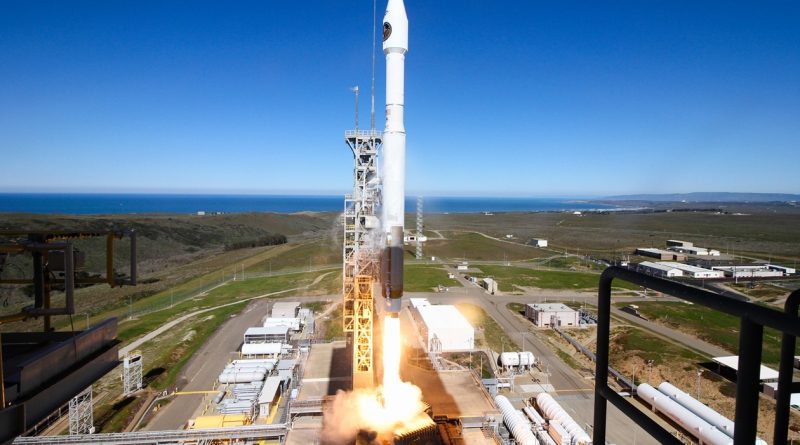Atlas V successfully Launches U.S. Government Surveillance Asset
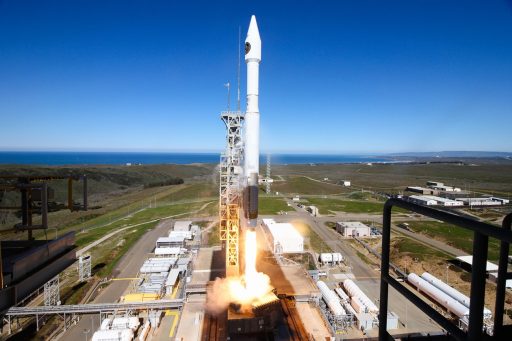
Thundering into orbit for the 70th time, ULA’s Atlas V rocket took to the skies on Wednesday, blasting off from California to haul a secret payload into orbit for the U.S. government. Nametagged NROL-79, the mission likely involved a pair of naval surveillance satellites under operation by the National Reconnaissance Office as part of a long-standing program dating back to the 1970s.
The 58-meter tall rocket gracefully lifted off its SLC-3E launch pad at 17:49 UTC on Wednesday, ascending into clear skies over Vandenberg Air Force Base. Atlas V quickly swung to the south-east on a coast-hugging trajectory, a rare flight path that was one of the major clues in identifying what was hidden under the rocket’s protective payload fairing.
The RD-180-powered first stage fired for just over four minutes before handing off to the trusted Centaur upper stage and its RL-10C engine to power the secret payload into orbit in what is presumed to be a two-burn flight profile taking the satellites into an orbit over 1,000 Kilometers in altitude.
Atlas V flew into the customary news blackout of NRO missions at the point of payload fairing separation four and a half minutes into the flight to allow NROL-79 to reach its classified orbit without the public watching. A confirmation of launch success was provided around one and a half hours after liftoff.
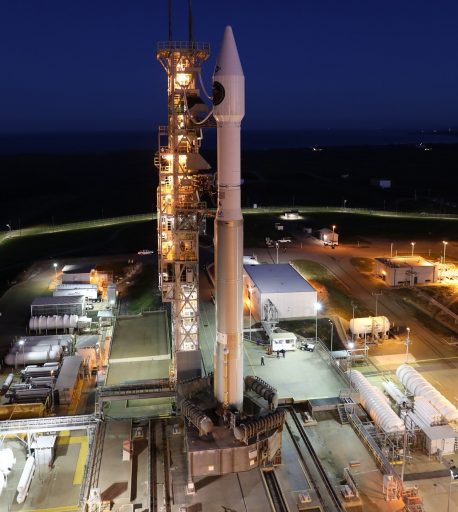
Wednesday’s launch marked the 70th mission for the Atlas V, looking back at a 15-year career during which the vehicle maintained a spotless record (from a customers point of view as one mission, also carrying a NOSS satellite duo reached a slightly improper orbit). It was the 35th mission of the basic Atlas V 401 without any boosters and the 14th Atlas V launch in support of the National Reconnaissance Office.
The NRO is one of numerous three-letter agencies in the U.S. government responsible for the collection and analysis of intelligence coming from various sources. Within the government’s spying machinery, the NRO is responsible for the design, manufacture and operation of U.S. reconnaissance satellites and support components, delivering satellite intelligence of other agencies such as the NSA, CIA and DIA that are in charge of processing the information.
Founded in 1961, the NRO operated in complete secrecy until 1992 when the existence of the agency was officially declassified, however, the various satellite programs under NRO operation remain closely guarded secrets. Occasional leaks and satellite trackers monitoring NRO spacecraft typically allow programs and their purposes to be uncovered and NROL-79 was no different.

Based on the type of launch vehicle, the launch site and the unique coast-hugging trajectory, NROL-79 can be identified with a high degree of certainty as the eighth mission in the third generation of the Naval Ocean Surveillance Satellite Program, or NOSS. Going by the codename ‘Intruder,’ satellites are operated in pairs that fly in precise formation to pin-point the position of foreign ships and aircraft by analyzing the delay in the arrival of the vessel’s radio signals at each of the satellites. This information is used by the military for general awareness and tactical planning.
NOSS started out as a program in the 1970s with the first satellites, back then flying in a triplet formation, reaching orbit in 1976. First generation satellites were launched until 1987 before the second generation took over, being deployed until 1996. With the introduction of the third generation came a reduction of the triplets to pairs of satellites.
Not much is known about the NOSS pairs – they are built by Lockheed Martin and their reported liftoff mass is 6,500 Kilograms for each pair. The satellites are operated from a 1,100-Kilometer orbit and replaced at a ten-year cadence with Wednesday’s launch fitting right into this scheme, likely involving the replacement satellites for the NOSS 3-4 pair launched in June 2007.
>>Identifying the classified NROL-79 Satellite(s)
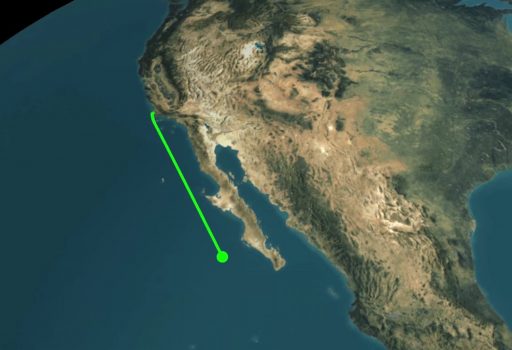
The NOSS satellites are launched into slightly elliptical orbits of around 1,010 by 1,200 Kilometers at an inclination of 63.4 degrees. Over their operational lives, the satellites’ orbit undergoes a natural progression caused by Earth’s gravitational field that will force an increase in orbital eccentricity. By selecting the proper starting conditions in terms of altitude and argument of perigee, the NOSS pairs can be kept within 100 Kilometers of their operational orbit for eight years without the need for maneuvering which could disrupt the precise formation of the duos.
Search parameters for Wednesday’s launch have been worked out by satellite spotters and the worldwide satellite tracking community will attempt to pin-point the satellites within hours or days of liftoff to calculate their orbit and provide a final confirmation of NROL-79’s identity.
The NROL-79 mission was originally booked for a December 1st liftoff that was postponed to late January after last September’s massive wildfire at Vandenberg that took out a number of communications and electrical lines required by the Western Range to support launch operations. A technical problem with the Centaur upper stage was discovered in mid-January during the mission’s Wet Dress Rehearsal requiring a month to fix and repeat the tanking test.
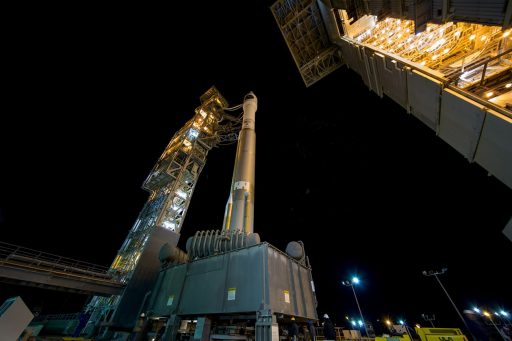
Having overcome the Canyon Fire and Centaur issue, it was fairly smooth sailing for NROL-79 – taking its place atop Atlas V in mid-February and going through a clean testing campaign leading up to Wednesday’s countdown. Weather forecasters had issued a rare 100% GO forecast before clocks started ticking just before two in the morning, local time.
While Atlas V was undergoing detailed checkouts, workers moved the large Mobile Service Tower to its launch position to clear the way for propellant loading that started when countdown operations resumed after a 30-minute hold at the T-2-hour mark. Over the course of the 90-minute tanking sequence, Atlas V’s first stage received 185,000 liters of -183°C Liquid Oxygen and Centaur was filled with 15,700 liters of oxidizer and 48,100 liters of -253°C Liquid Hydrogen. The booster had received its dose of 94,600 liters of Rocket Propellant 1 ahead of the day’s countdown.
Atlas V checked off a repetition of communications checks and tested its Flight Termination System before receiving the proper flight software and undergoing final checks on the hydraulic and pneumatic systems. The countdown held again for half an hour at T-4 minutes, facilitating the final configuration of the classified spacecraft and the critical poll of all launch controllers that revealed everything was in readiness for liftoff.
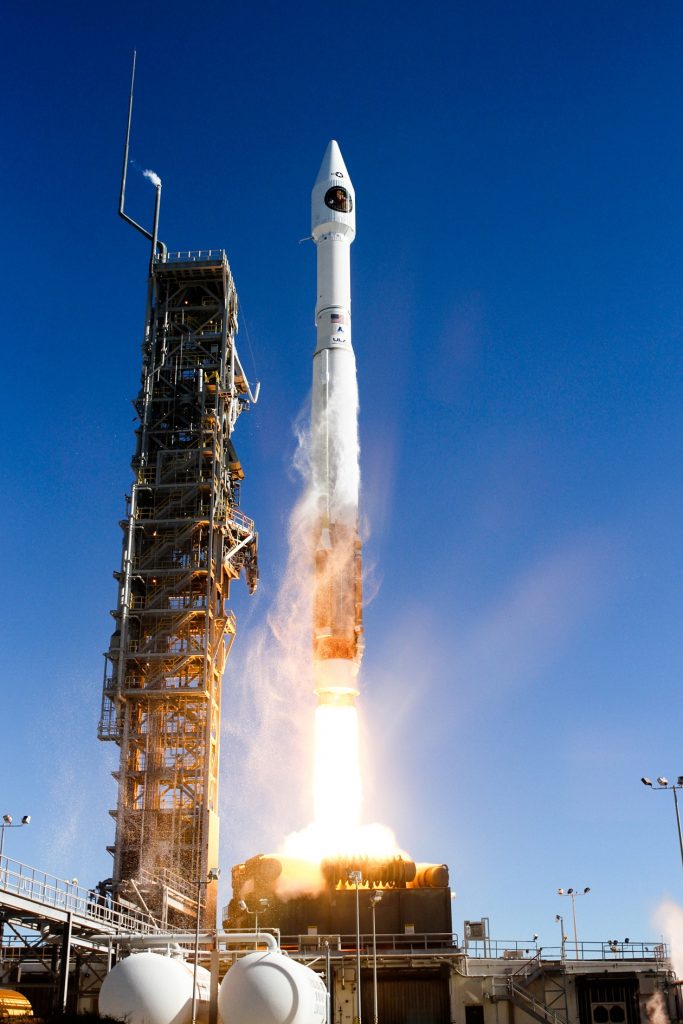
Pressing into its Automated Countdown Sequence, Atlas V began pressurizing tanks on both stages, prepared the Flight Termination System and transitioned to battery power before assuming control of the last computer-controlled checks and reconfigurations. With the onboard computers in charge, Atlas V reached a stable flight pressure on all tanks and the final status check gave the approval for ignition.
Atlas V came to life as its two-chamber main engine soared to 392 metric ton-force of thrust to lift the 335-ton rocket off the ground at precisely 17:49:51 UTC. The usual slow liftoff was followed by 17 seconds of vertical ascent before Atlas V pitched and rolled to attain a south-easterly heading, utilizing what is known as a coast-hugging trajectory.
Burning 1,150 Kilograms of propellant per second, Atlas V quickly picked up the pace and pushed through the sound barrier 81 seconds into the flight followed by the area of Maximum Dynamic Pressure some eight seconds later. Heading up the hill, Atlas V enabled Zero-Angle of Attack flight mode which controls the attitude of the launcher using a pre-programmed attitude profile based on atmospheric conditions ahead of the transition to closed loop control after passing through the dense atmosphere.
While the first stage was burning at a peak vacuum thrust of 422 metric ton-force, Centaur readied for its ignition by chilling down the turbomachinery of its RL-10 engine and pressurizing its Hydrazine-fueled attitude control system.
Atlas V throttled back in advance of Booster Engine Cutoff four minutes and three seconds into the mission. Six seconds later, the 32.5-meter long Common Core Booster separated from the Centaur to hand off propulsive flight duties to the seasoned upper stage.
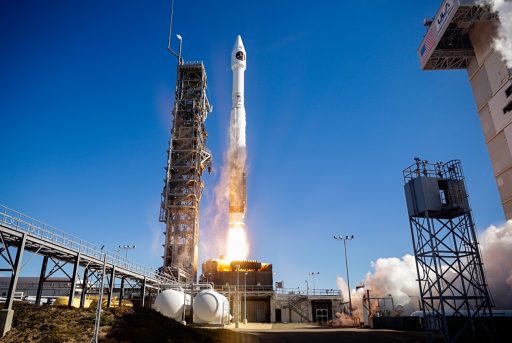
Centaur fired up its 10,400 Kilogram-force RL-10 engine ten seconds after staging to begin a lengthy burn to push the stack into an elliptical parking orbit. After eight seconds of second stage operation, the four-meter payload fairing was split open and separated from the ascending rocket, revealing the NROL-79 payload for the rest of its way into orbit and marking the end of public mission coverage as has become standard for the NRO’s hush-hush satellite launches.
Per the standard flight profile expected for NOSS missions, Centaur was set for a long first burn into a transfer orbit peaking over 1,000 Kilometers in altitude ahead of half an orbit of coasting so that the second burn could bring up the perigee and inject the satellites into a 1,010 by 1,200-Kilometer orbit at an inclination of 63.4-degrees. In line with previous NOSS missions, launch success was announced 100 minutes after liftoff.
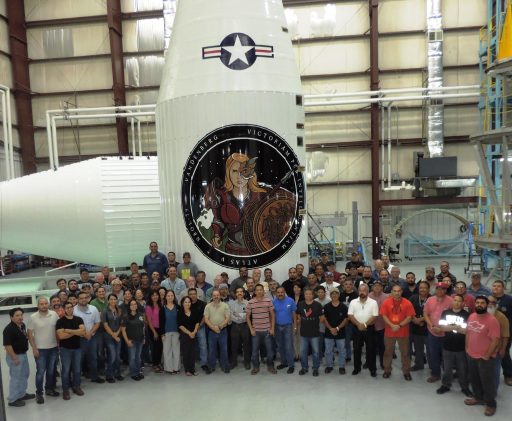
The confirmation of mission success will be the last heard of NROL-79 as the mission drifts into full secrecy. Satellite spotters are at the ready to track the satellites’ first moves in orbit and monitor where they will enter the NOSS constellation. Per the typical procedure, the two newest additions will be operational within eight months of launch, signaled by an older NOSS pair drifting out of formation at the end of its operational mission.
For United Launch Alliance, Wednesday’s launch marked the start of a ‘March Madness’ of sorts with the next mission just one week away as a Delta IV rocket is prepared for liftoff on March 8th with the WGS-9 military communications satellite. After that it will be Atlas V’s turn again, lifting the Cygnus OA-7 cargo resupply ship into orbit on March 20 (UTC) on a mission to the International Space Station.

